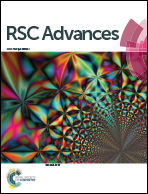Solution-processable low-bandgap 3-fluorothieno[3,4-b]thiophene-2-carboxylate-based conjugated polymers for electrochromic applications†
Abstract
In this paper, a series of low-bandgap donor–acceptor (D–A) conjugated polymers with 3-fluorothieno[3,4-b]thiophene-2-carboxylate (FTT) as an acceptor and ethylenedioxythiophene (EDOT) (P1), acyclic dioxythiophene (AcDOT) (P2) or propylenedioxythiophene (ProDOT) (P3) as donors were synthesized via Stille polymerization. The resultant polymers have good solubility in organic solvents. The polymers were characterized by gel permeation chromatography (GPC), nuclear magnetic resonance spectroscopy (NMR) and thermogravimetric analysis (TGA). Their electrochemical, morphological and electrochromic (EC) properties were investigated, and their absorption-transmission type electrochromic devices (ECDs) were fabricated and characterized. In their neutral states, the polymers displayed deep magenta (P1) to blue (P2, P3) hues, and upon electrochemical oxidation, they revealed grey tones with good optical contrasts (19–37 and 57–58% in visible and near-infrared (NIR) regions, respectively), good coloration efficiencies (158–380 and 279–378 cm2 C−1 for visible and NIR regions, respectively) and reasonable redox stability (retaining 64–80% original optical contrast after 1000 cycles) under ambient conditions and without any encapsulation of the ECDs.
![Graphical abstract: Solution-processable low-bandgap 3-fluorothieno[3,4-b]thiophene-2-carboxylate-based conjugated polymers for electrochromic applications](/en/Image/Get?imageInfo.ImageType=GA&imageInfo.ImageIdentifier.ManuscriptID=C5RA19956E&imageInfo.ImageIdentifier.Year=2015)

 Please wait while we load your content...
Please wait while we load your content...